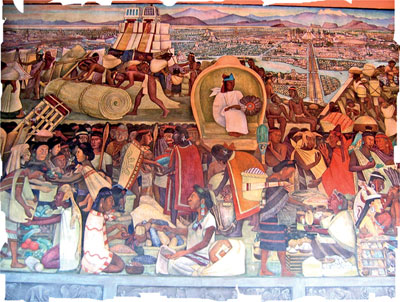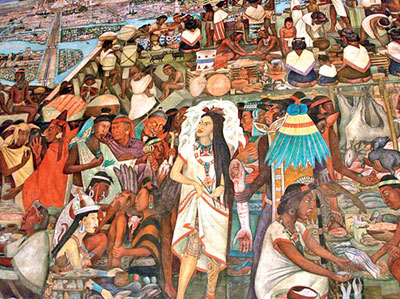Introduction to modern Latin American fiction - Part 1
The purpose of this Article is, in the first instance, to introduce
briefly the history of Latin America and the conquest and subsequent
changes to the ethnic and social landscape. Secondly, I will touch upon
the different modes of story telling both before and during the conquest
of what is today known as Latin American.

Then I will look at Modernism and explain how it is the precursor to
the literary Boom of the 1960s which put Latin America on the literary
map. My discussion on the Boom will include a brief explanation of
Magical Realism which is a key pointer in Boom. I will then discuss this
in relation to Gabriel Garcia Marquez’s “One hundred years of solitude”.
This will then be contrasted with Isabel Allende’s “The house of the
spirits”, illustrating the progression from what is known as the Boom to
the movement which followed it - the Post-Boom. This will include the
interface which exists between art and society and examine how Latin
American literature addresses matters of politics and both national and
personal identity.
The age of discovery and conquest is one of the most fascinating
periods in of the whole history of Latin America. The discovery and
subsequent conquest of the Americas was the single most important
cultural encounter in history, a sequence of events that rocked the Old
World and profoundly influenced events that were to follow and therefore
the New World.
The indigenous peoples of the Americas are the pre-Columbian
inhabitants of North and South America, their descendants, and the many
ethnic groups who identify with those peoples. They are often also
referred to as Native Americans, Aboriginals and First Nations.
Application of the term "Indian" originated with Columbus, who
thought that he had arrived in the East Indies, while seeking Asia.
Later the name was still used as the Americas at the time were often
called West Indies. This has served to imagine a kind of racial or
cultural unity for the aboriginal peoples of the Americas.
Once created, the unified "Indian" was codified in law, religion, and
politics. The unitary idea of "Indians" was not originally shared by
indigenous peoples, but many over the last two centuries have embraced
the identity.
According to the New World migration model, a migration of humans
from Eurasia to the Americas took place via a land bridge which
connected the two continents across what is now the Bering Strait.
The most recent point at which this migration could have taken place
is 12,000 years ago, with the earliest period remaining a matter of some
unresolved contention. These early Paleo-Indians soon spread throughout
the Americas, diversifying into many hundreds of culturally distinct
nations and tribes.
According to the oral histories of many of the indigenous peoples of
the Americas, they have been living there since their genesis, described
by a wide range of traditional creation accounts.
Many parts of the Americas are still populated today by indigenous
Americans. Some countries have sizable populations, such as Bolivia,
Peru, Mexico,Guatemala, Colombia, and Ecuador.
 At
least a thousand different indigenous languages are spoken in the
Americas and certain indigenous peoples still live in relative isolation
from Western society, afew
being counted as uncontacted peoples. At
least a thousand different indigenous languages are spoken in the
Americas and certain indigenous peoples still live in relative isolation
from Western society, afew
being counted as uncontacted peoples.
Many pre-Columbian civilizations established characteristics and
hallmarks which included permanent, urban settlements, agriculture,
civic and monumental architecture, and complex societal hierarchies.
Some of these civilizations had long faded by the time of the first
permanent European arrivals (late 15th–early 16th centuries), and are
known only through archaeological investigations. Others were
contemporary with this period, and are also known from historical
accounts of the time.
A few, such as the Maya, had their own written records. However, most
Europeans of the time viewed such texts as heretical, and much was
destroyed in Christian pyres. Only a few hidden documents remain today,
leaving modern historians with glimpses of ancient culture and
knowledge.
According to both indigenous American and European accounts and
documents, American civilizations at the time of European encounter
possessed many impressive accomplishments. For instance, the Aztecs
built one of the most impressive cities in the world, Tenochtitlan, the
ancient site of Mexico City, with an estimated population of 200,000.
American civilizations also displayed impressive accomplishments in
astronomy and mathematics. American Indian creation myths tell of a
variety of origination of their respective peoples. Some were "always
there" or were created by gods or animals, some migrated from a
specified compass point, and others came from "across the ocean".
Conquests and treaties
The first explorations and conquests were made by the Spanish and the
Portuguese, immediately following their own final reconquest of Iberian
lands in 1492. In the 1494 Treaty of Tordesillas, ratified by the Pope,
these two kingdoms divided the entire non-European world between
themselves, with a line drawn through South America.
Based on this Treaty, and the claims by Spanish explorer Vasco Núñez
de Balboa to all lands touching the Pacific Ocean. With help from their
powerful Indian allies, the Spanish rapidly conquered territory, with
Hernan Cortes overthrowing the Aztec and Francisco Pizarro conquering
the Inca Empire.
As a result, they gained control of much of western South America,
Central America and Mexico by the mid-16th century, in addition to its
earlier Caribbean conquests. Over this same timeframe, Portugal
colonised much of eastern South America, naming it Brazil.
Other European nations soon disputed the terms of the Treaty of
Tordesillas, which they had not negotiated. England and France attempted
to plant colonies in the Americas in the 16th century, but these met
with failure.
However, in the following century, the two kingdoms, along with the
Dutch Republic, succeeded in establishing permanent colonies. Some of
these were on Caribbean islands, which had often already been conquered
by the Spanish or depopulated by disease, while others were in eastern
North America, which had not been colonized by Spain north of Florida.
As more nations gained an interest in the colonization of the
Americas, competition for territory became increasingly fierce.
Colonists often faced the threat of attacks from neighboring
colonies, as well as from indigenous tribes and pirates.
It is from the blend of European and indigenous cultures, which Latin
America is well known for that that the rich literary tradition has
developed.
Chronicles written by the Conquistadors
Pre-Columbian cultures were primarily oral, though the Aztecs and
Mayans, for instance, produced elaborate codices.
Oral accounts of mythological and religious beliefs were also
sometimes recorded after the arrival of European colonisers, as was the
case with the Popol Vuh. Moreover, a tradition of oral narrative
survives to this day, for instance among the Quechua-speaking population
of Peru and the Quiché of Guatemala.
From the very moment of Europes "discovery" of the continent, early
explorers and conquistadors produced written accounts and cronicles of
their experience—such as Columbuss letters or Bernal Díaz del Castillos
description of the conquest of Mexico.
During the colonial period, written culture was often in the hands of
the church, within which context Sor Juana Inés de la Cruz wrote
memorable poetry and philosophical essays. Towards the end of the 18th
Century and the beginning of the 19th, a distinctive criollo literary
tradition emerged.
The 19th Century was a period of "foundational fictions" (in critic
Doris Sommers words), novels in the Romantic or Naturalist traditions
that attempted to establish a sense of national identity, and which
often focused on the indigenous question or the dichotomy of
"civilization or barbarism".
At the turn of the 20th century, Modernism emerged; a poetic movement
whose founding text was Rubén Daríos Azul (1888). This was the first
Latin American literary movement to influence literary culture outside
of the region, and was also the first truly Latin American literature,
in that national differences were no longer so much an issue.
Modernist literature is the literary expression of the tendencies of
Modernism. Modernistic art and literature normally revolved around the
idea of individualism, mistrust of institutions (government, religion)
and the disbelief in any absolute truths. Modernism itself is marked by
a strong and intentional break with tradition.
This break includes a strong reaction against established religious,
political, and social views. Modernists believe the world is created in
the act of perceiving it; that is, the world is what we say it is.
Modernists do not subscribe to absolute truth.
All things are relative. Modernists feel no connection with history
or institutions. Their experience is often that of alienation, loss, and
despair. Modernists champion the individual and celebrate inner
strength. They believe life is unordered and concern themselves with the
sub-conscious.
It is Modernism that leads us onto the literary boom of the 1960s and
1970s which really put Latin American literature on the global map. Both
the Boom and post Boom literary genres will be examined in detail next
week. |

